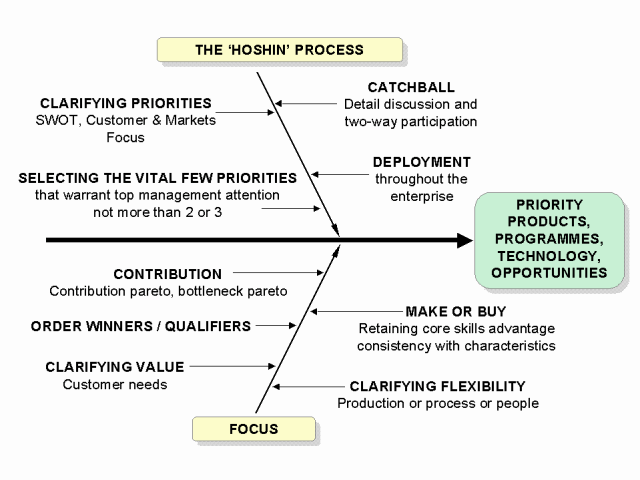
Lean and POLICY DEPLOYMENT

The Japanese name for policy deployment now adopted increasingly by Lean companies to guide operations strategy.
Clarifying Priorities and SWOT Analysis is generally the first step. This involves conventional strategic management steps.
Hoshin (from a Japanese word meaning Helmsman) believes that top management should be concerned with a few priorities only. Steer the tanker but the rest of the ship can run itself. Hence, 2 or 3 areas should be selected for attention to change. Change is vital, but also difficult, so should not be confused with ongoing operations.
Once top level priorities are decided they are discussed, level by level, throughout the organisation. Detail is added, feedback is given, and refienements are made.
Final policies are deployed level by level throughout the organisation. Measure development is an important part: each level setting its own measures that contribute to the achievement of higher level measures.
An important set of strategic decisions that have to be made whether or not there is a Hoshin process in operation. Achieving focus is a pre-requisite to Lean operations.
Do a Pareto analysis of product contribution. Frequently, a long tail of products that make little or negative contribution is found. Use this to think about product line rationalisation. In companies with important bottleneck processes, do an analysis by contribution per bottleneck minute used. The last thing you want is products making very low contribution but which also tie up your precious bottleneck process.
Ask what do we need to do to get into the stadium? (qualifiers) and what do we need to do to win the game? (winners). Hence make sure that the operations are capable of delivering.
One definition of value is performance / cost. What is it that customers value in your products and services. Some mix of cost, quality, delivery, flexibility, speed and service. People, process and capacity decisions depend upon this knowledge.
Unlike Henry Ford, most companies cannot make everything. So what to make or buy depends upon answers to the above questions, plus considerations such as retention of core skills both now and in the future, capability to make what customers want, and avoiding operations complexity.